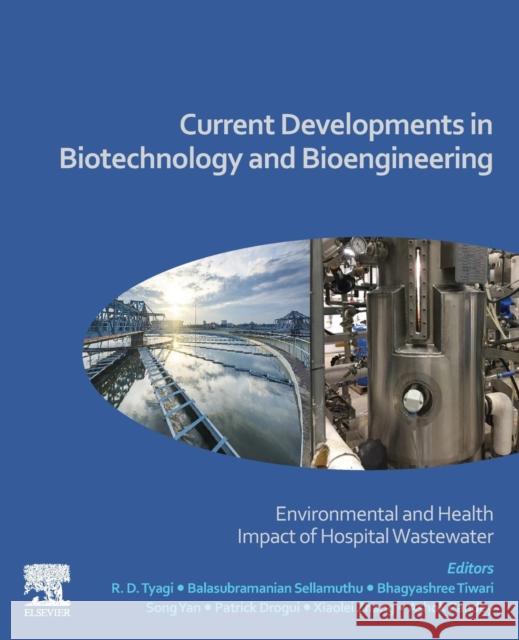Current Developments in Biotechnology and Bioengineering: Environmental and Health Impact of Hospital Wastewater » książka



Current Developments in Biotechnology and Bioengineering: Environmental and Health Impact of Hospital Wastewater
ISBN-13: 9780128197226 / Angielski / Miękka / 2020 / 612 str.
Current Developments in Biotechnology and Bioengineering: Environmental and Health Impact of Hospital Wastewater
ISBN-13: 9780128197226 / Angielski / Miękka / 2020 / 612 str.
(netto: 834,48 VAT: 5%)
Najniższa cena z 30 dni: 869,02
ok. 30 dni roboczych
Bez gwarancji dostawy przed świętami
Darmowa dostawa!
1. Introduction to wastewater microbiology: special emphasis on hospital wastewater
1.1 Introduction
1.2 History of wastewater origin and treatment
1.3 History of microbiology and pathogens discovery
1.4 Antibiotic discovery
1.5 Pharmaceuticals in hospital wastewater
1.6 Presence of pharmacological substances in aquatic environment
1.7 Conclusion and future perspectives
Abbreviations
References
2. Pharmaceutical metabolites and their by-products in hospital wastewater
2.1 Introduction
2.2 Pharmaceutical metabolites and their classification
2.3 Route of entry and fate of pharmaceutical compounds
2.4 Metabolism and transformation mechanism of pharmaceutical compounds
2.5 Ecotoxicity of pharmaceutical compounds
2.6 Detection of pharmaceutical compounds
2.7 Conclusions and perspectives
Abbreviations
References
3. Physical, chemical, and biological impact (hazard) of hospital wastewater on environment: presence of pharmaceuticals, pathogens, and antibiotic-resistance genes
3.1 Introduction
3.2 Pharmaceuticals and pathogens in hospital wastewater
3.3 The development of antibiotic resistance genes
3.4 The transportation of pharmaceuticals and pathogens in the environment
3.5 The prevention of pharmaceuticals and pathogens into environment
3.6 Conclusions and perspectives
References
4. Microbiology of hospital wastewater
4.1 Introduction
4.2 Microorganisms and pathogens originating from hospital wastewater
4.3 Antibiotic-resistance genes prevalence in environment
4.4 Tools used to identify antibiotic-resistance genes
4.5 Metagenomics of hospital wastewater
4.6 Horizontal gene transfer
4.7 Emerging infectious particles
4.8 Conclusions and perspectives
Abbreviations
5. Fate of pathogens and viruses in hospital wastewater and their treatment methods
5.1 Introduction
5.2 Pathogen surveillance and detection in hospital wastewater
5.3 Types of pathogens present in hospital wastewater
5.4 Treatment methods available for pathogens present in hospital wastewater
5.5 Treated water monitoring and analysis
5.6 Summary
5.7 Conclusions and perspectives
Abbreviations
References
6. Multidrug-resistant genes and pathogenic bacteria in hospital wastewater
6.1 Introduction
6.2 Origin and mechanism of drug resistance
6.3 Antifungal drug resistance
6.4 Antibiotic-resistance bacteria
6.5 Antibiotic-resistance genes
6.6 Conclusions and perspectives
Abbreviations
References
7. Cancer treatment drugs and endocrine-disrupting chemicals release and fate in hospital wastewater
7.1 Introduction
7.2 List of chemicals released in the hospital wastewater
7.3 Endocrine-disrupting chemicals
7.4 Challenges in hospital wastewater treatment
7.5 Conclusions and perspectives
Abbreviations
References
8. Pharmaceuticals roles in microbial evolution
8.1 Introduction
8.2 Microbial evolution and adaptation
8.3 Aquatic environment microbiology
8.4 Soil microbiology
8.5 Effect on plants, animals, and humans in long run
8.6 Conclusions and perspectives
Abbreviations
References
9. Present scenario of antibiotic use in veterinary practice: importance of wastewater microbiology
9.1 Introduction
9.2 Antibiotic released in veterinary applications
9.3 Microbial association with animals
9.4 Dissemination of animal pathogens to environment
9.5 Animal viruses in wastewater
9.6 Recent studies on wastewater associated with animals
9.7 Molecular detection of veterinary pathogens
9.8 Policy interventions in animal health
9.9 Conclusions and perspectives
Abbreviations
References
10. Bacteriophages isolated from hospital wastewater and its role in controlling drug-resistant pathogens
10.1 Introduction
10.2 Background of bacteriophages (F)
10.3 Classification of bacteriophages
10.4 Phages commonly found in hospital wastewater
10.5 Role of phages in drug-resistance gene transfer
10.6 General (vast) applications of bacteriophages in different fields
10.7 Limitations of phage use in real world applications
10.8 Removal of phages from wastewater treatment plant
10.9 Conclusions and perspectives
Abbreviations
References
11. Development of molecular methods to detect and control emerging drug-resistance pathogens
11.1 Introduction
11.2 Antibiotic-resistance gene-carrying plasmidome in the cultivable microbial community
11.3 Molecular tools/biosensors development for detection
of drug-resistance bacteria and genes
11.4 Recent approaches to control drug resistance development
11.5 Conclusions and perspectives
Abbreviations
References
12. Riboswitches and aptamers: potential future targets
to control drug-resistant bacteria
12.1 Introduction
12.2 History of riboswitches and aptamers
12.3 Role of riboswitches
12.4 Applications of aptamers
12.5 Engineering bacteria using riboswitches and aptamers
12.6 Conclusions and perspectives
Abbreviations
References
13. Treatment of wastewater containing pharmaceuticals: biological treatment
13.1 Introduction
13.2 Activated sludge process
13.3 Sequential batch reactor
13.4 Membrane bioreactor
13.5 Fluidized bed biofilm reactor and moving bed biofilm
reactor
13.6 The impact of property of pharmaceuticals on the removal
13.7 Novel methods and advanced treatment options
13.8 Engineering aspects to improve pharmaceuticals removal with biological process of wastewater treatment
13.9 Technical and economical evaluation of biological processes
13.10 Treatment systems for small flows
13.11 Effect of climate change on the microbiology of the biological treatment process in removing the pharmaceuticals
13.12 Conclusions and perspectives
Abbreviations
References
Further reading
14. Role of chemical treatments in pharmaceuticals degradation and its consequences and environmental risks
14.1 Introduction
14.2 Photocatalysis
14.3 Fenton-type processes
14.4 The electrochemical advance oxidation process
14.5 Treatment of pharmaceutical pollutants by combined wastewater treatment processes
14.6 By-products identification
14.7 Technoeconomic comparison for various hospital wastewater treatment processes
14.8 Challenges in the treatment process
14.9 Conclusion and perspectives
References
Further reading
15. Hospital wastewater treatment scenario around the globe
15.1 Introduction
15.2 Global scenario of hospital wastewater treatment
15.3 Status of hospital wastewater management in developed countries
15.4 Status of hospital wastewater management in developing countries
15.5 Other countries
15.6 Conclusions and perspectives
Abbreviations
References
16. Guidelines for hospital wastewater discharge
16.1 Introduction
16.2 Guideline of hospital wastewater discharge to municipal sewer
16.3 On-site treatment of hospital wastewater
16.4 Worker's health and safety principles
16.5 Conclusions and perspectives
Abbreviations
References
17. Future impacts and trends in treatment of hospital wastewater
17.1 Introduction
17.2 Emerging infectious diseases
17.3 Threats
17.4 Required research action and proposed remedies
17.5 Effect of global warming on pathogens survival
17.6 Conclusions and perspectives
Abbreviations
References
1997-2025 DolnySlask.com Agencja Internetowa
KrainaKsiazek.PL - Księgarnia Internetowa









